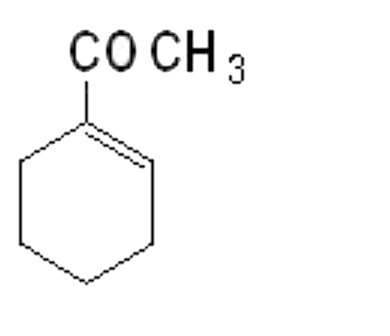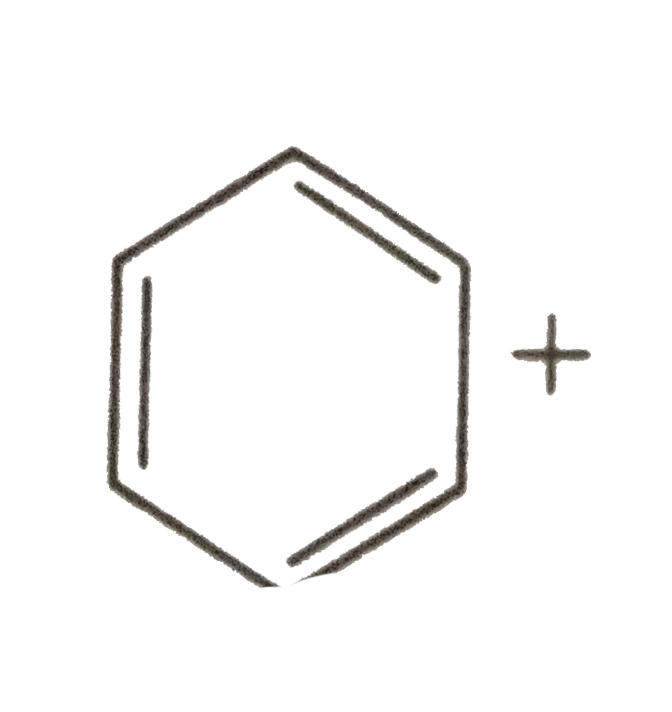OHC(CH2)3COCH3OH−−−→Δ
The major product is ?




The correct Answer is:A
To solve the problem, we need to analyze the reaction of the compound OHC(CH₂)₃COCH₃ in the presence of a base (OH⁻) and heat. This reaction involves aldehyde condensation, where we have both an aldehyde group (CHO) and a ketone group (COCH₃).
1. Identify Functional Groups:
The compound has an aldehyde group (CHO) and a ketone group (COCH₃). The structure can be represented as:
CHO - CH2−CH2−CH2−CO - CH3
2. Recognize Reaction Type:
The presence of a base (OH⁻) and heat indicates that we are dealing with an aldol condensation reaction. This reaction typically occurs between aldehydes or between an aldehyde and a ketone.
3. Identify Alpha Hydrogens:
Both the aldehyde and the ketone have alpha hydrogens. The aldehyde has three alpha hydrogens (from the CH₂ groups), and the ketone has one alpha hydrogen (from the CH₃ group).
4. Deprotonation:
The base (OH⁻) will deprotonate one of the alpha hydrogens to form an enolate ion. The enolate can form from either the aldehyde or the ketone.
- If the enolate forms from the aldehyde, it will be:
CH2−CH2−CH2−C−=O−CH3
- If it forms from the ketone, it will be:
C−−O−CH3
5. Nucleophilic Attack:
The enolate ion will then attack the carbonyl carbon of the other carbonyl compound present in the reaction.
- If the enolate was formed from the aldehyde, it will attack the ketone.
- If the enolate was formed from the ketone, it will attack the aldehyde.
6. Formation of the β-Hydroxy Carbonyl Compound:
After the nucleophilic attack, we will form a β-hydroxy carbonyl compound. This compound will have both the aldehyde and ketone functionalities.
7. Dehydration:
Upon heating, the β-hydroxy carbonyl compound will undergo dehydration (loss of water) to form an α,β-unsaturated carbonyl compound.
8. Final Product:
The final product will be a six-membered ring compound due to the formation of a stable cyclic structure during the reaction. The major product is an α,β-unsaturated carbonyl compound.
Conclusion:
The major product of the reaction is an α,β-unsaturated carbonyl compound, which corresponds to the structure of a cyclohexene derivative.
The compound has an aldehyde group (CHO) and a ketone group (COCH₃). The structure can be represented as:
CHO - CH2−CH2−CH2−CO - CH3
The presence of a base (OH⁻) and heat indicates that we are dealing with an aldol condensation reaction. This reaction typically occurs between aldehydes or between an aldehyde and a ketone.
Both the aldehyde and the ketone have alpha hydrogens. The aldehyde has three alpha hydrogens (from the CH₂ groups), and the ketone has one alpha hydrogen (from the CH₃ group).
The base (OH⁻) will deprotonate one of the alpha hydrogens to form an enolate ion. The enolate can form from either the aldehyde or the ketone.
- If the enolate forms from the aldehyde, it will be:
CH2−CH2−CH2−C−=O−CH3
- If it forms from the ketone, it will be:
C−−O−CH3
The enolate ion will then attack the carbonyl carbon of the other carbonyl compound present in the reaction.
- If the enolate was formed from the aldehyde, it will attack the ketone.
- If the enolate was formed from the ketone, it will attack the aldehyde.
After the nucleophilic attack, we will form a β-hydroxy carbonyl compound. This compound will have both the aldehyde and ketone functionalities.
Upon heating, the β-hydroxy carbonyl compound will undergo dehydration (loss of water) to form an α,β-unsaturated carbonyl compound.
The final product will be a six-membered ring compound due to the formation of a stable cyclic structure during the reaction. The major product is an α,β-unsaturated carbonyl compound.
The major product of the reaction is an α,β-unsaturated carbonyl compound, which corresponds to the structure of a cyclohexene derivative.
Similar Questions
Knowledge Check
CH2=CH−CH=CH2CCl3Br−−−−→product. The major product is :
ABr−CH2−CH=CH−CH2−CCl3BCH2=CH−CH∣Br−CH2−CCl3CCH2=CH−CH∣CCl3−CH2−BrDnone is correctCH3−C≡C−CH3BH3⋅THF−−−−−−→CH3COOHMajor product :
ACH3−CH2−O∣∣C−CH3BCH3CH2CH2−O∣∣C−HC D
D
CH3−CH3∣C∣CH3−O−CH2−CH3Cold and conc.−−−−−−−−→HI?
The product is
View SolutionMajor product of given reaction is -
O2N−CH2−C∣ClH−CH3ΘOH−−→Δ Major product
View SolutionThe product of the reaction is CH3−CH2−O∣∣C−OAgBr2−−−−−→Δ Major product
View SolutionIn the given reaction the products is :
CH3−CH2−C∣∣O−OCH3+CH3−C∣∣O−OCH3(1)CH3OΘNa+−−−−−−−−−−→(2)CH3OHoversert(H2O)−−→Δ product
View Solution +Cl−CH2CH2CH3AlCl3−−→P(i)O2/Δ−−−−−−−−→(ii)H2OQ+ Phenol
+Cl−CH2CH2CH3AlCl3−−→P(i)O2/Δ−−−−−−−−→(ii)H2OQ+ Phenol
The major products P and Q are :
View SolutionBenzene +Cl−CH2CH2CH3AlCl3−−→P(i)O2/Δ−−−−−−−−→(ii)H2OQ+
Phenol The major products P and Q are :
View Solution
